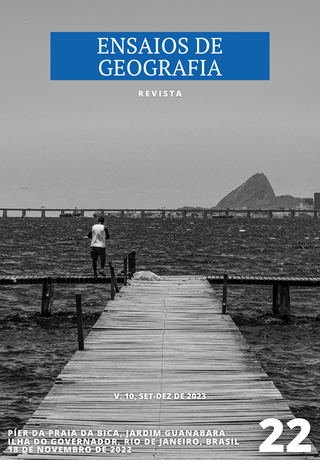AN EXPERIENCE REPORT FOR THINKING ABOUT REGIONAL DEVELOPMENT BASED ON THE ROSE PRODUCTION SECTOR
from Barbacena/MG (BR) to the global flower market
DOI:
https://doi.org/10.22409/eg.v10i22.59244Keywords:
Global Production Network, Regional Development, Global Flower Market, Economic GeographyAbstract
Through the daily monitoring of a florist store as a mandatory internship activity, several were the movements about, mainly, the main peak dates that intensify the dynamics of the global flower market annually. Throughout this process, the rose appears as the most consumed flower in this branch. This observation led to an investigation in order to unveil and understand the relationships of the rose production sector in the spheres of production, distribution, marketing and consumption, revealing the actors involved, their intentions and the main places that contribute to the insertion of the rose in a Global Production Network (GPR). To this end, the concept of GPR guided the research carried out and the use of its theoretical basis served to mediate an empirical search for information from interviews with two individuals who are members of the rose production sector in Barbacena, Minas Gerais. With this in view, this experience report seeks to contribute to reflections on regional development through economic geography approaches.
Downloads
References
ALVES, A. M.; VIANA, T. V. de A.; AZEVEDO, B. M. de; JOVINO, M. R. M.; FURLAN, R. A. EFEITOS DE NÍVEIS DE IRRIGAÇÃO SOBRE A CULTURA DA ROSA. IRRIGA, [S. l.], v. 13, n. 2, p. 152–159, 2008. DOI: 10.15809/irriga.2008v13n2p152-159. Disponível em: <https://irriga.fca.unesp.br/index.php/irriga/article/view/3358>. Acesso em: 20 dez. 2023.
AHMED, J. U.; LINDA, I. J.; MAJID, M. A. Royal FloraHolland: Strategic Supply Chain of Cut Flowers Business. SAGE Business Cases. SAGE Publications: SAGE Business Cases Originals, 2018.
BEZERRA, J. E. Redes globais de produção: um caminho de análise para a geografia econômica. GEOUSP Espaço e Tempo (Online), [S. l.], v. 25, n. 3, p. 149-167, 2021. DOI: 10.11606/issn.2179-0892.geousp.2021.187413. Disponível em: <https://www.revistas.usp.br/geousp/article/view/187413>. Acesso em: 20 dez. 2023.
CARVALHO, D. R. P.; VELOSO FILHO, F. A. Geografia econômica: origem, perspectivas e temas relevantes/Economic Geography: beginnings, perspectives and relevant issues. Caderno de Geografia, v. 27, n. 50, p. 573-588, 2017. Disponível em: <https://periodicos.pucminas.br/index.php/geografia/article/view/p.2318-2962.2017v27n50p573>. Acesso em: 20 dez. 2023.
CEPEA; IBRAFLOR. PIB da cadeia de Flores e Plantas Ornamentais brasileira: ano-base 2017. 2022. Disponível em: <https://www.cepea.esalq.usp.br/br/pib-da-cadeia-de-flores-e-plantas-ornamentais.aspx>
DUARTE, R. Entrevistas em pesquisas qualitativas. Educar em revista, n. 24, p. 213-225, 2004.
GALERIANI, T. M. ; COSMO, B. M. N. ; CECCON, A. P. P. ; MARCHI, C. S. ; MUNDT, T. T. Cultivo de rosas de corte. Revista Agronomia Brasileira, v.4, 2020. Disponível em: <https://www.fcav.unesp.br/#!/ensino/departamentos/ciencias-da-producao-agricola/laboratorios/labmato/rab/volume-4-2020/rab202003/>. Acesso em: 20 dez. 2023.
GRANADA, D. F., et al. Industria de las flores en Colombia. [Diplomado de profundización para grado, Universidad Nacional Abierta y a Distancia UNAD]. 2019.
GRISOTTO, M. C. O sistema agroindustrial de exportação de rosas: um estudo comparativo entre o Brasil e a Colômbia. 2019. Tese de Doutorado. Universidade de São Paulo.
MARTINS, M. J. De Amesterdão a Lisboa. O negócio das flores vale milhões. Diário de Notícias, 09 de março de 2020. Disponível em: <https://www.dn.pt/1864/de-amesterdao-a-lisboa-o-negocio-das-flores-vale-milhoes-11886810.html>. Acesso em: 23 de junho de 2023.
NASTARI, P. M. A crise na Ucrânia e a dependência da importação de fertilizantes. AgroANALYSIS, v. 42, n. 5, p. 16-17, 2022. Disponível em: <https://periodicos.fgv.br/agroanalysis/article/view/88024#:~:text=A%20depend%C3%AAncia%20do%20Brasil%20por,em%20risco%20a%20agropecu%C3%A1ria%20nacional.>. Acesso em: 20 dez. 2023.
SANTOS, M. Modo de produção técnico-científico e diferenciação espacial. Revista Território, v. 4, n. 6, p. 5-20, 1999. Disponível em: <https://edisciplinas.usp.br/pluginfile.php/7611596/mod_resource/content/1/Modo%20de%20Producao%20Tecnico%20Cient%C3%ADfico%20e%20Diferencia%C3%A7%C3%A3o%20Espacial.pdf>. Acesso em: 20 dez. 2023
SANTOS, M. A natureza do espaço: técnica e tempo, razão e emoção. Edusp, 1996.
SCHOLVIN, S. .; SERRA, M. .; FRANÇOSO, M.; BASTOS, P. .; MELLO, P. .; BORGES, A. . Densidade, distância, divisão e as redes de produção globais: o caso do setor brasileiro de petróleo e gás. Economia e Sociedade, Campinas, SP, v. 29, n. 1, p. 85–119, 2020. Disponível em: <https://periodicos.sbu.unicamp.br/ojs/index.php/ecos/article/view/8661920>. Acesso em: 20 dez. 2023.
WEBERING, S. I. Cooperação cooperativa: O ser, o fazer e o devir. Revista de Administração Contemporânea, v. 24, p. 567-581, 2020. Disponível em: <https://www.scielo.br/j/rac/a/pkxKPqLjmVBdnKqKxwsBB4n/?lang=pt>. Acesso em: 20 dez. 2023.
Published
How to Cite
Issue
Section
License
Copyright (c) 2023 Da Revista (Ensaios de Geografia) e do Autor

This work is licensed under a Creative Commons Attribution 4.0 International License.
CC BY Attribution. Others may distribute, remix, transform, and build upon the material for any purpose, even commercially, provided they give the author and licensor the credits.


